Overview
If you're looking to snag some bookkeeping clients for your small agency, the first step is to nail down your ideal client profile. From there, you'll want to build a credible online presence that really showcases what you can offer. Don't forget to tap into networking opportunities—those connections can be gold! Creating value-driven content is key, too; it helps you stand out and show potential clients what you're all about. And let's not overlook the power of a solid client referral program. This article dives into these five steps in detail, highlighting how crucial it is to understand client demographics, use effective marketing strategies, and build genuine relationships to attract and keep clients. So, are you ready to get started on this journey?
Introduction
In a competitive landscape where small agencies are trying to make their mark, attracting and keeping bookkeeping clients can feel like an uphill battle. This article lays out a strategic roadmap, packed with actionable insights to help bookkeeping professionals:
- Pinpoint their ideal clients
- Establish a trustworthy online presence
- Tap into networking opportunities
But what do you do when the usual marketing tricks just don’t cut it? Let’s explore how fresh approaches to client engagement and referral programs can revolutionize the way bookkeeping agencies connect with potential clients, paving the way for long-term success in a constantly changing market.
Define Your Ideal Client Profile
To effectively define your ideal client profile, let’s dive into some key aspects that matter:
-
Demographics: Think about the age, gender, location, and income level of your target clients. For example, if you’re focusing on small agencies, you might want to target owners aged 30-50 in urban areas. This demographic often seeks out professional bookkeeping services, providing an excellent opportunity to understand how to get bookkeeping clients!
-
Business Type: What types of businesses do you want to serve? Are they mainly service-oriented, product-based, or a mix of both? Getting clear on this helps you tailor your offerings to meet their unique needs.
-
Pain Points: What challenges do your ideal customers face with bookkeeping? Common issues might include tax compliance headaches, cash flow management struggles, or the need for accurate financial reporting. By identifying these pain points, you can show how to get bookkeeping clients by presenting your services as the perfect solutions. Fun fact: only 14% of accounting practices use management software, which highlights a big opportunity for you to add value!
-
Goals: What are your customers hoping to achieve by hiring a bookkeeper? This could range from saving time and reducing stress to improving financial accuracy and compliance. Understanding their goals lets you align your offerings with how to get bookkeeping clients effectively.
-
Budget: It’s also important to consider your ideal customers’ financial capacity. Knowing their budget helps you position your solutions effectively, ensuring that your options are within reach for them.
By gathering this information, you can create a detailed customer persona that not only guides your marketing strategies but also shapes your offerings. This ultimately leads to better customer satisfaction and retention. As Jennifer Moore, founder of Moore Details, wisely puts it, "Picking the right clients is key to your firm's long-term success.
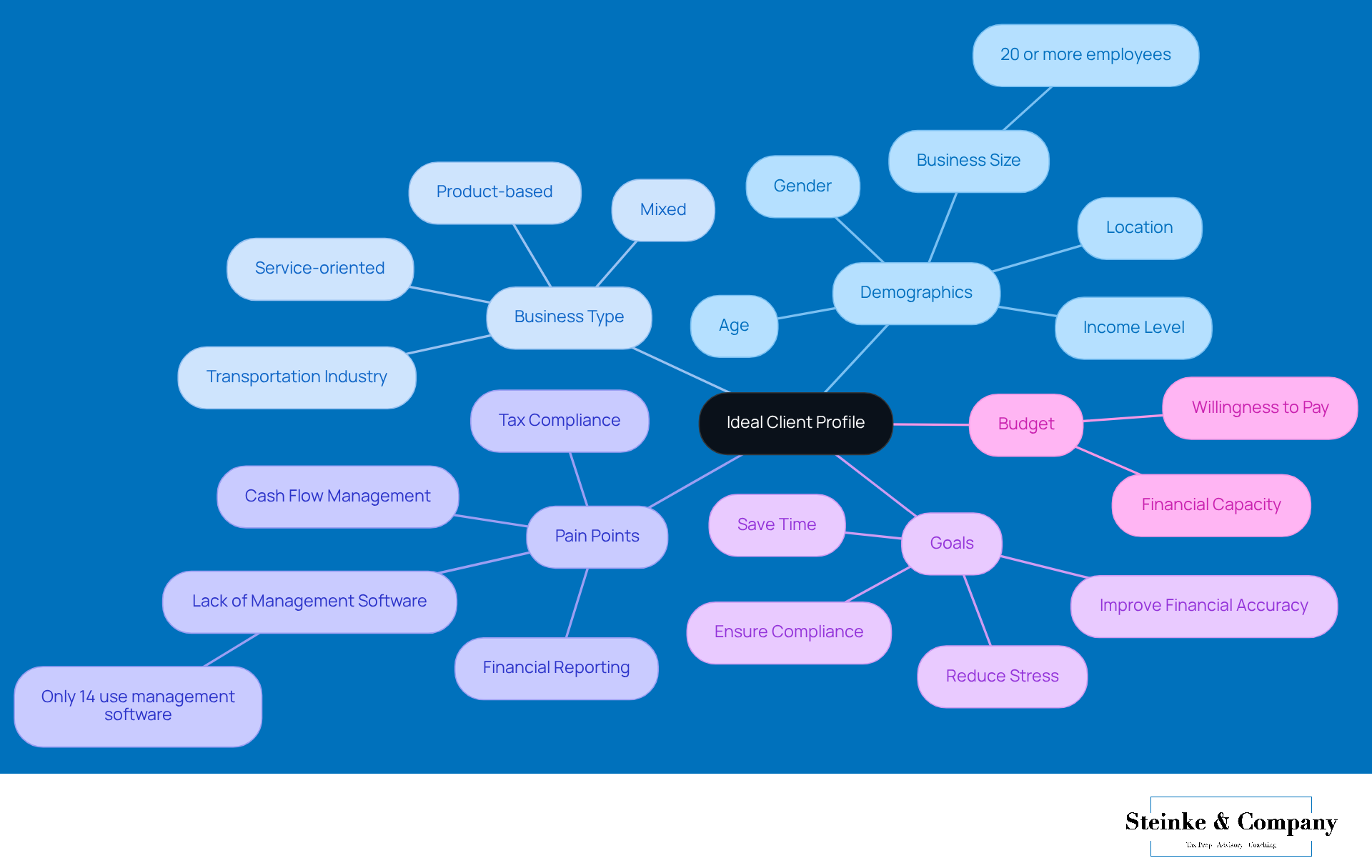
Build a Credible Online Presence
To build a credible online presence, just follow these simple steps:
-
Establish a Professional Website: Your site should clearly detail what you offer, showcase testimonials, and feature a blog with valuable content. Make sure it’s mobile-friendly and easy to navigate—after all, nobody likes a clunky site!
-
Optimize for SEO: Use relevant keywords related to bookkeeping and small business services to boost your search engine ranking. This way, prospective customers can find you more easily. And don’t forget to regularly update your Google Business Profile; it’s crucial for maintaining visibility and enhancing your local SEO efforts.
-
Utilize Social Media: Set up profiles on platforms like LinkedIn, Facebook, and Instagram. Share industry insights, customer success stories, and engage with your audience to build a community. Consistency in posting not only fosters trust but keeps your brand front and center for potential customers. Plus, tracking and analyzing your social media performance can help measure ROI and tweak your strategies as needed.
-
Gather Testimonials and Reviews: Encourage happy customers to leave positive feedback on your website and social media. This social proof can really sway potential customers’ decisions—who doesn’t love a good recommendation?
-
Engage in Online Communities: Join forums and groups related to small business and bookkeeping. By offering advice and insights on how to get bookkeeping clients, you position yourself as an expert in the field, and who wouldn’t want that?
-
Leverage Email Marketing: Implement email marketing campaigns—they can generate significant returns, about $36 for every $1 spent! This strategy helps capture leads and keeps the conversation going with your customers.
-
Incorporate Video Content: Use video to showcase your expertise and engage your audience. Video is becoming essential for visibility and can really help attract potential customers.
By applying these strategies, you can create a strong online presence that not only draws in but also keeps customers coming back for more!
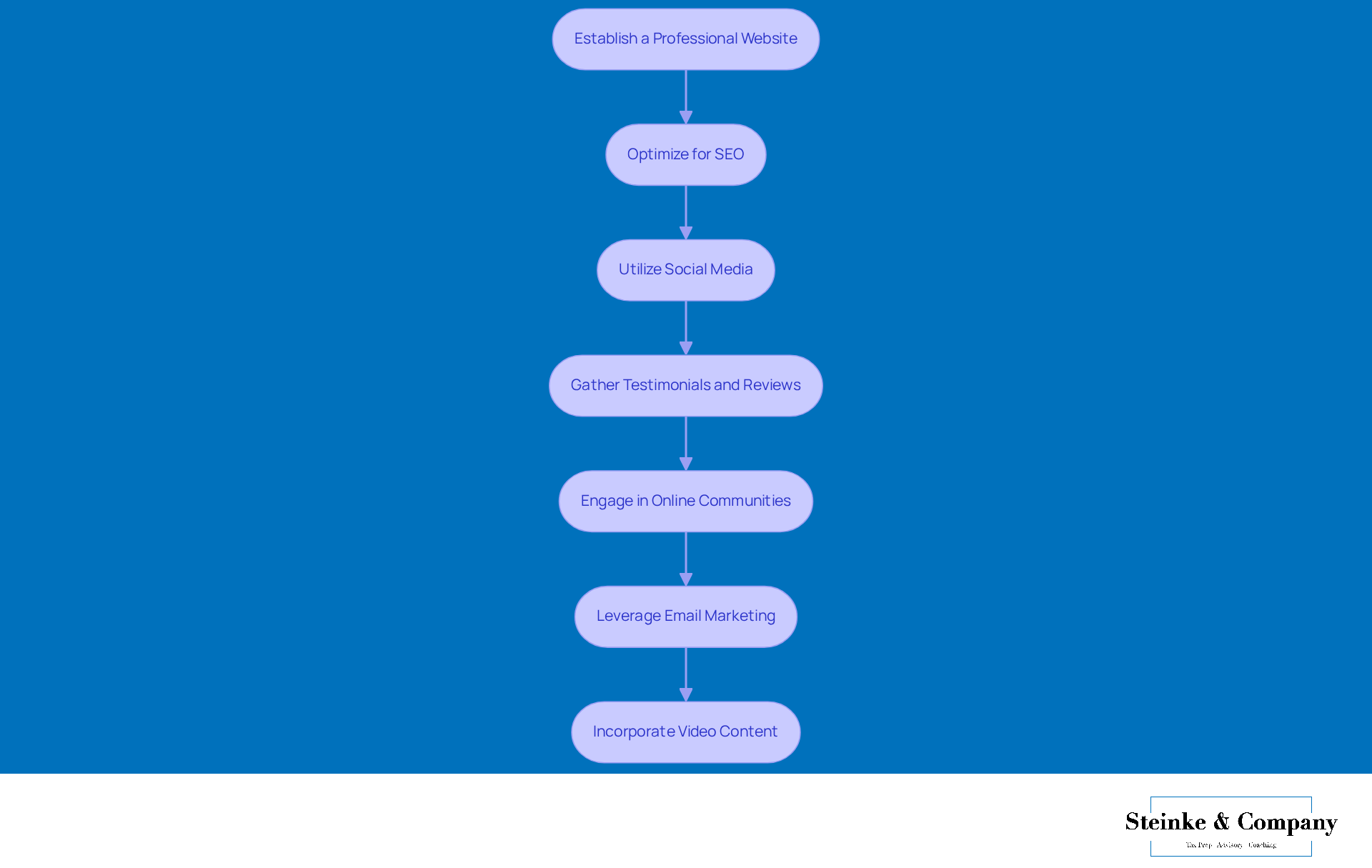
Leverage Networking Opportunities
To effectively leverage networking opportunities, consider these friendly strategies:
-
Attend Industry Events: Dive into conferences, workshops, and seminars focused on bookkeeping and small enterprises. These gatherings are fantastic chances to connect with potential customers and industry leaders, providing insights on how to get bookkeeping clients while boosting your visibility in the market. As Luis Rivero, a CPA, puts it, "Imagine the invaluable connections you could establish in an environment brimming with like-minded individuals who share your passion for the industry."
-
Join Professional Associations: Becoming a member of organizations like the American Institute of Professional Bookkeepers (AIPB) or local enterprise groups can really open doors to valuable networking opportunities and resources that support your growth.
-
Host Workshops or Webinars: By sharing your expertise through educational sessions, you position yourself as a go-to resource. This not only showcases your skills but also demonstrates how to get bookkeeping clients who are keen on your services.
-
Utilize LinkedIn: Build connections with other professionals in your field on LinkedIn. Sharing valuable content and engaging with your network fosters relationships that can lead to new business opportunities. This platform is especially advantageous for bookkeeping experts who want to understand how to get bookkeeping clients.
-
Follow Up: After meeting new contacts, shoot them a follow-up email or message to keep the conversation going. This simple act helps solidify connections and can lead to fruitful collaborations.
And hey, don’t forget to check out specific upcoming events like the Latino Tax Fest or the Digital CPA Conference, which offer great networking opportunities and CPE credits. By actively engaging in networking, you can cultivate meaningful relationships that pave the way for new clients and opportunities.
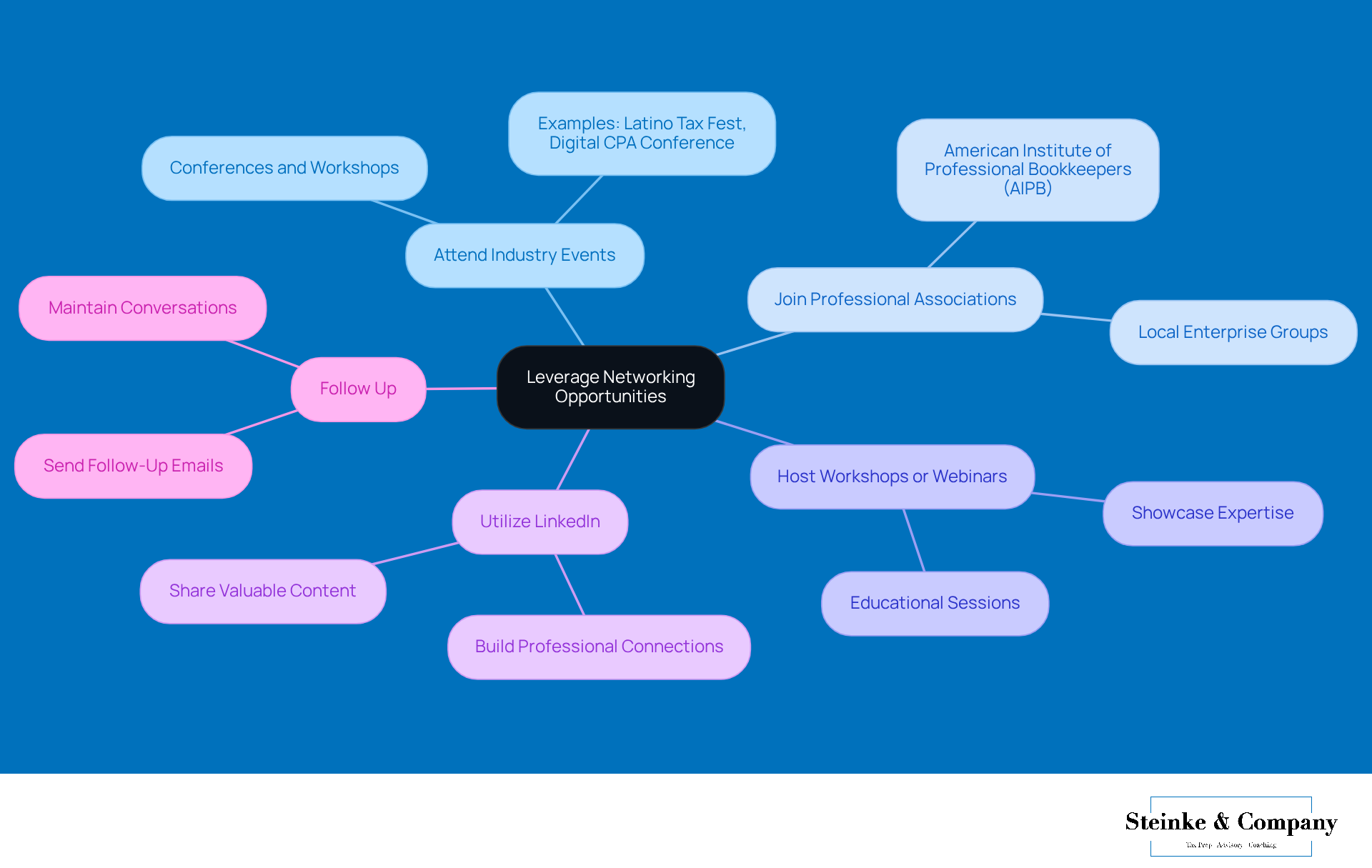
Create Value-Driven Content
To create value-driven content, let’s explore some strategies together:
-
Identify Topics of Interest: Start by researching the common questions and challenges your target audience faces. Tools like Google Trends or social media polls can help you gather insights into what entrepreneurs are really seeking.
-
Write Blog Posts: Craft informative articles that tackle these topics. For instance, consider writing about tax advice for local businesses or efficient cash flow management techniques—these are super relevant and in high demand right now.
-
Develop Guides and Checklists: Offer downloadable resources, like a comprehensive bookkeeping checklist or a detailed tax preparation guide. These can be invaluable tools for your clients! Don’t forget to highlight the importance of a compliance checklist that emphasizes encrypting sensitive customer information and using multi-factor authentication—these are essential for safeguarding enterprises.
-
Utilize Video Content: Create short videos that break down complex topics into simple terms. Video content tends to be more engaging and shareable, making it a fantastic way to reach a wider audience. Think about making videos that outline steps small business owners should take to prepare for IRS audits, helping them understand their rights and ease their stress during the process.
-
Share on Multiple Platforms: Distribute your content across various channels, like your website, social media, and email newsletters. This multi-platform approach ensures you reach a broader audience and boosts your visibility.
By consistently creating valuable content, you can learn how to get bookkeeping clients while positioning yourself as a trustworthy authority in the field. And guess what? Statistics show that businesses prioritizing content marketing see a significant increase in customer engagement and retention—making this strategy crucial for growth!
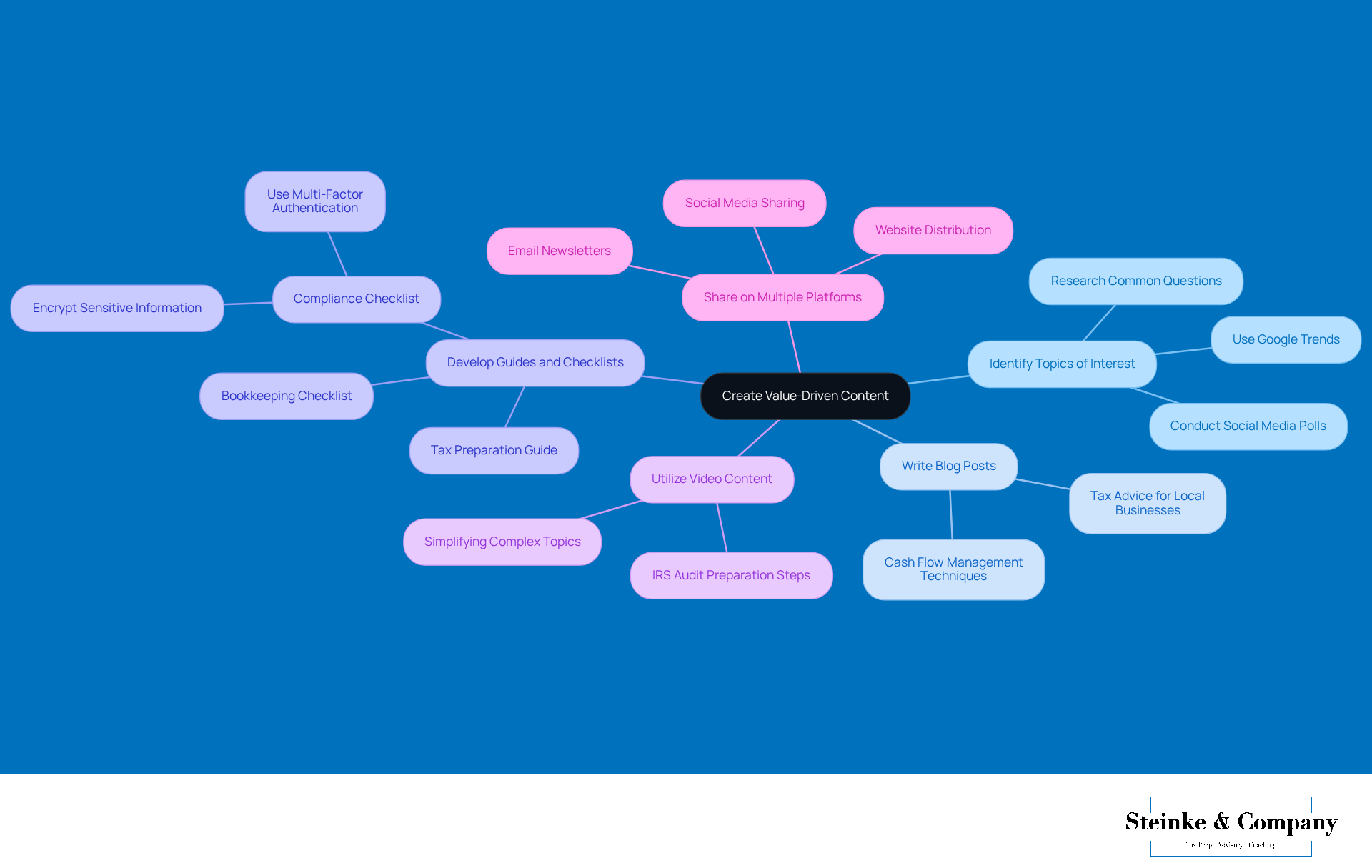
Develop a Client Referral Program
Creating an effective client referral program can be a game-changer for your business. Let’s dive into some essential steps you can take:
-
Define Incentives: First things first, think about the rewards you want to offer your customers for successful referrals. Common incentives include discounts on future purchases, gift cards, or even cash bonuses. Did you know that for small businesses, incentives typically range from 10% off upcoming invoices to cash rewards of $50 for each new customer referred? For bookkeeping firms, you might also consider service upgrades or donations to a charity of the referrer’s choice—this really appeals to customers who want to make a positive impact!
-
Communicate the Program: Make sure your current customers are in the loop about the referral program. Use various channels like email, social media, and even face-to-face meetings to spread the word. It’s important that they understand how the program works and what benefits they can reap from participating. Targeted email marketing and social media sharing can be super effective in promoting your program too.
-
Make it Simple: Keep the referral process straightforward by providing your customers with handy resources, like email templates or social media posts. This not only boosts participation but also reduces the effort required from them, making it more likely they’ll recommend others.
-
Track Referrals: You’ll want a solid system in place to keep track of referrals and ensure customers get their rewards promptly. Using referral software can make this a breeze, offering features like tracking, analytics, and campaign management to measure how well your program is doing.
-
Show Appreciation: Always take a moment to thank customers who refer others, even if that referral doesn’t turn into a sale. This simple act fosters goodwill and encourages ongoing participation in your referral program. Think about unique rewards for your top referrers, like handwritten notes, care packages, or exclusive memberships, to really strengthen those relationships.
By putting together a well-structured referral program, you can tap into your existing client relationships to discover how to get bookkeeping clients and create new business opportunities. This not only enhances your agency's growth but also sets you up for long-term success!
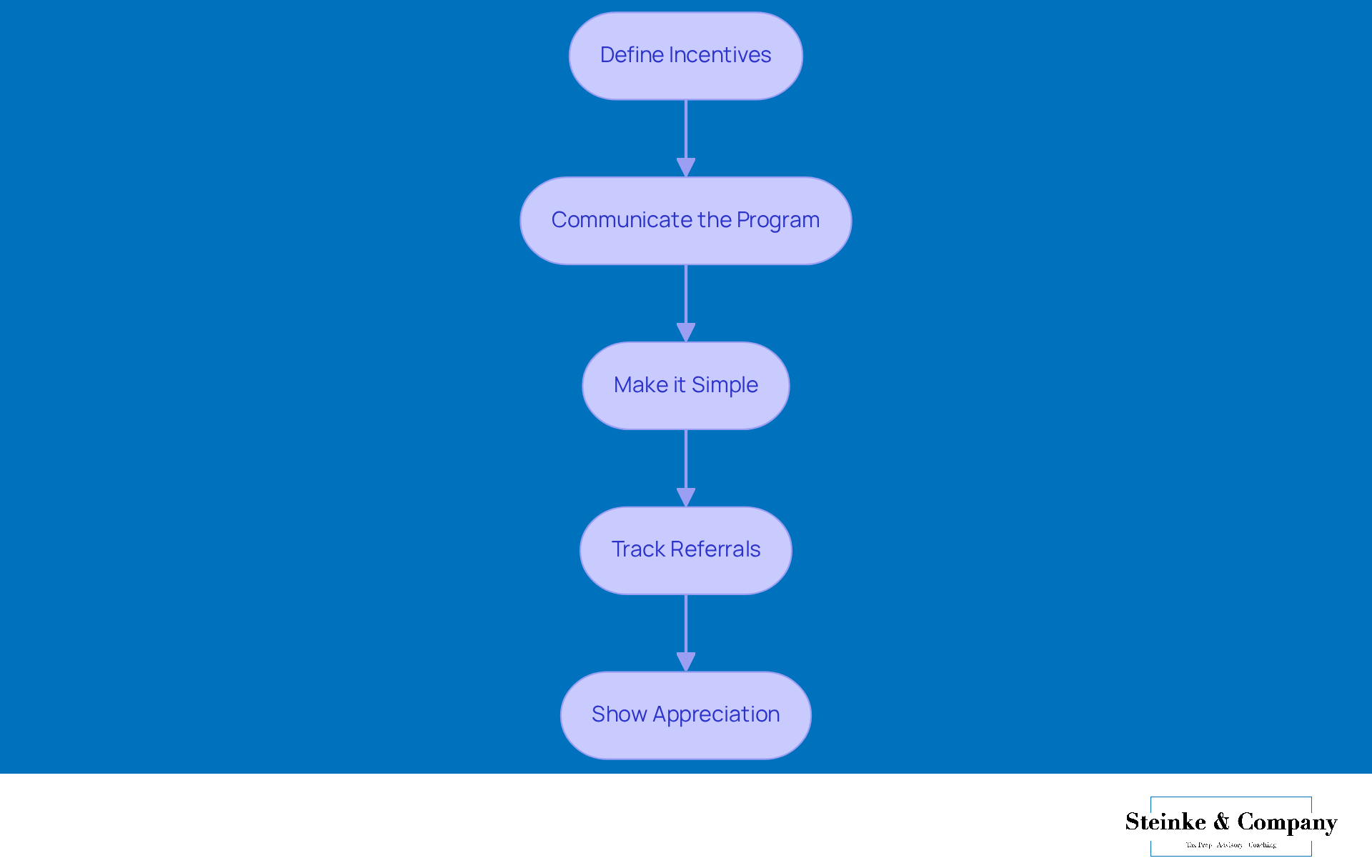
Conclusion
Defining and attracting bookkeeping clients is all about strategy! It involves understanding your ideal client profile, establishing a credible online presence, leveraging networking opportunities, creating value-driven content, and developing a client referral program. By honing in on these key areas, small agencies can position themselves to meet their target audience's needs while boosting their visibility and reputation in the market.
Throughout this article, we’ve outlined some essential strategies. For starters, defining your ideal client helps you tailor your services to address specific needs and pain points. Building a strong online presence with a professional website and active social media engagement fosters trust and attracts potential clients. Plus, networking at industry events and joining professional associations can open doors to valuable connections. And let’s not forget about creating informative content—it’s a great way to establish authority in your field. Lastly, implementing a client referral program can turn satisfied customers into powerful advocates for your business.
So, to wrap things up, the journey to acquiring bookkeeping clients isn’t just about marketing; it’s about building meaningful relationships and providing genuine value. By integrating these strategies into your business model, small bookkeeping agencies can attract new clients and cultivate lasting partnerships that contribute to long-term success. Embracing these practices will help your agency stand out in a competitive landscape, ultimately leading to growth and sustainability. How about giving these ideas a shot? You might just find they make a world of difference!
Frequently Asked Questions
What is an ideal client profile and why is it important?
An ideal client profile is a detailed description of the characteristics of your target clients, including demographics, business type, pain points, goals, and budget. It is important because it guides your marketing strategies and shapes your offerings, leading to better customer satisfaction and retention.
What demographic factors should I consider when defining my ideal client?
Consider factors such as age, gender, location, and income level. For example, if targeting small agencies, you might focus on owners aged 30-50 in urban areas.
How can I identify the business types I want to serve?
Determine whether you want to serve service-oriented businesses, product-based businesses, or a mix of both. This clarity helps tailor your offerings to meet their unique needs.
What common pain points do clients face regarding bookkeeping?
Common challenges include tax compliance issues, cash flow management struggles, and the need for accurate financial reporting. Identifying these pain points allows you to present your services as solutions.
What goals do clients typically have when hiring a bookkeeper?
Clients may aim to save time, reduce stress, improve financial accuracy, and ensure compliance. Understanding these goals helps align your services with their needs.
Why is it important to consider clients' budgets?
Knowing your ideal customers' financial capacity allows you to position your solutions effectively, ensuring that your offerings are affordable and accessible to them.
What steps can I take to build a credible online presence?
Establish a professional website, optimize for SEO, utilize social media, gather testimonials and reviews, engage in online communities, leverage email marketing, and incorporate video content.
How can I optimize my website for search engines?
Use relevant keywords related to bookkeeping and small business services, regularly update your Google Business Profile, and ensure your website is mobile-friendly and easy to navigate.
What role does social media play in building an online presence?
Social media helps build a community by sharing industry insights, customer success stories, and engaging with your audience. Consistent posting fosters trust and keeps your brand visible.
How can testimonials and reviews influence potential customers?
Positive feedback from satisfied customers serves as social proof, which can significantly sway potential customers' decisions in favor of your services.
Why should I engage in online communities related to my field?
Participating in forums and groups allows you to offer advice and insights, positioning yourself as an expert in bookkeeping, which can attract potential clients.
What is the potential return on investment for email marketing?
Email marketing can generate significant returns, approximately $36 for every $1 spent, making it an effective strategy for capturing leads and maintaining customer engagement.
How can video content enhance my online presence?
Video content showcases your expertise and engages your audience, becoming essential for visibility and attracting potential customers.




